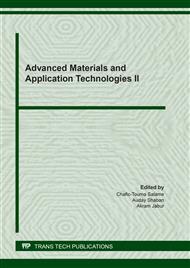[1]
E. Fortunato et al., ZnO:Ga Thin Films Produced by RF Sputtering at Room Temperature: Effect of the Power Density,, Materials Science Forum 455–456 (2004) 12–15.
DOI: 10.4028/www.scientific.net/msf.455-456.12
Google Scholar
[2]
G. M. Wu, Y. Ding, D. W. Gao, G. J. Xing, Y. Zhou, and T. L. Yin, Electrochemical Deposition and Properties Research of ZnO Thin Films,, Advanced Materials Research 669 (2013) 72–78.
DOI: 10.4028/www.scientific.net/amr.669.72
Google Scholar
[3]
C. H. Sui, B. Liu, T. N. Xu, B. Yan, and G. Y. Wei, Effect of the ZnO Buffer Layer Thickness on AZO Film Properties,, Advanced Materials Research 562–564 (2012) 81–84.
DOI: 10.4028/www.scientific.net/amr.562-564.81
Google Scholar
[4]
High Performance ZnO-SnO2:F Nanocomposite Transparent Electrodes for Energy Applications | ACS Applied Materials & Interfaces., https://pubs.acs.org/doi/abs/10.1021/am5034473 (accessed Apr. 26, 2021).
Google Scholar
[5]
D. S. Ginley and J. D. Perkins, Transparent Conductors,, in Handbook of Transparent Conductors, D. S. Ginley, Ed. Boston, MA: Springer US (2011) 1–25.
DOI: 10.1007/978-1-4419-1638-9_1
Google Scholar
[6]
J. Garnier, Elaboration de couches minces d'oxydes transparents et conducteurs par spray cvd assiste par radiation infrarouge pour applications photovoltaÏques,, phdthesis, Arts et Métiers ParisTech, (2009).
Google Scholar
[7]
F. Z. Bedia, A. Bedia, M. Aillerie, N. Maloufi, F. Genty, and B. Benyoucef, Influence of Al-doped ZnO Transparent Contacts Deposited by a Spray Pyrolysis Technique on Performance of HIT Solar Cells,, Energy Procedia 50 (2014) 853–861.
DOI: 10.1016/j.egypro.2014.06.104
Google Scholar
[8]
F. Z. Bedia, A. Bedia, M. Aillerie, N. Maloufi, and B. Benyoucef, Structural, Optical and Electrical Properties of Sn-doped Zinc Oxide Transparent Films Interesting for Organic Solar Cells (OSCs),, Energy Procedia 74 (2015) 539–546.
DOI: 10.1016/j.egypro.2015.07.745
Google Scholar
[9]
E. Fortunato, P. Barquinha, and R. Martins, Oxide Semiconductor Thin-Film Transistors: A Review of Recent Advances,, Advanced Materials 24 (2012) 2945–2986. doi: https://doi.org/10.1002/adma.201103228.
DOI: 10.1002/adma.201103228
Google Scholar
[10]
R. Gordon, Criteria for Choosing Transparent Conductors, (2000).
Google Scholar
[11]
G. Haacke, New figure of merit for transparent conductors,, Journal of Applied Physics 47 (1976) 4086–4089.
DOI: 10.1063/1.323240
Google Scholar
[12]
R. G. Gordon, Preparation and Properties of Transparent Conductors,, MRS Online Proceedings Library (OPL) 426 (1996).
Google Scholar
[13]
R. Das, K. Adhikary, and S. Ray, The role of oxygen and hydrogen partial pressures on structural and optical properties of ITO films deposited by reactive rf-magnetron sputtering,, Applied Surface Science 253 (2007) 6068–6073.
DOI: 10.1016/j.apsusc.2007.01.107
Google Scholar
[14]
E. Medvedovski, N. A. Alvarez, C. J. Szepesi, O. Yankov, and P. Lippens, Advanced indium tin oxide ceramic sputtering targets (rotary and planar) for transparent conductive nanosized films,, Advances in Applied Ceramics 112 (2013) 243–256.
DOI: 10.1179/1743676112y.0000000066
Google Scholar
[15]
M. Huang, Z. Hameiri, H. Gong, W.-C. Wong, A. G. Aberle, and T. Mueller, Novel Hybrid Electrode Using Transparent Conductive Oxide and Silver Nanoparticle Mesh for Silicon Solar Cell Applications,, Energy Procedia 55 (2014) 670–678.
DOI: 10.1016/j.egypro.2014.08.043
Google Scholar
[16]
V. Srikant and D. R. Clarke, On the optical band gap of zinc oxide,, Journal of Applied Physics 83 (1998) 5447–5451.
DOI: 10.1063/1.367375
Google Scholar
[17]
S. Roy and S. Basu, Improved zinc oxide film for gas sensor applications,, Bull Mater Sci 25 (2002) 513–515.
DOI: 10.1007/bf02710540
Google Scholar
[18]
C. Battaglia et al., Nanomoulding of transparent zinc oxide electrodes for efficient light trapping in solar cells,, Nature Photonics 5 (2011).
DOI: 10.1038/nphoton.2011.198
Google Scholar
[19]
O. Isabella, F. Moll, J. Krč, and M. Zeman, Modulated surface textures using zinc-oxide films for solar cells applications,, Physica Status Solidi (a) 207 (2010) 642–646. doi: https://doi.org/10.1002/pssa.200982828.
DOI: 10.1002/pssa.200982828
Google Scholar
[20]
S. Kim, H. Moon, D. Gupta, S. Yoo, and Y. Choi, Resistive Switching Characteristics of Sol–Gel Zinc Oxide Films for Flexible Memory Applications,, IEEE Transactions on Electron Devices 56 (2009) 696–699.
DOI: 10.1109/ted.2009.2012522
Google Scholar
[21]
P.-K. Shin, Y. Aya, T. Ikegami, and K. Ebihara, Application of pulsed laser deposited zinc oxide films to thin film transistor device,, Thin Solid Films 516 (2008) 3767–3771.
DOI: 10.1016/j.tsf.2007.06.068
Google Scholar
[22]
S. Vyas, A Short Review on Properties and Applications of Zinc Oxide Based Thin Films and Devices : ZnO as a promising material for applications in electronics, optoelectronics, biomedical and sensors,, Johnson Matthey Technology Review 64 (2020) 202–218.
DOI: 10.1595/205651320x15694993568524
Google Scholar
[23]
K. Ellmer, Magnetron sputtering of transparent conductive zinc oxide: relation between the sputtering parameters and the electronic properties,, J. Phys. D: Appl. Phys. 33 (2000) R17.
DOI: 10.1088/0022-3727/33/4/201
Google Scholar
[24]
K. Al Abdullah, S. Awad, J. Zaraket, and C. Salame, Synthesis of ZnO Nanopowders By Using Sol-Gel and Studying Their Structural and Electrical Properties at Different Temperature,, Energy Procedia 119 (2017) 565–570.
DOI: 10.1016/j.egypro.2017.07.080
Google Scholar
[25]
T. Tohsophon, J. Hüpkes, H. Siekmann, B. Rech, M. Schultheis, and N. Sirikulrat, High rate direct current magnetron sputtered and texture-etched zinc oxide films for silicon thin film solar cells,, Thin Solid Films 516 (2008) 4628–4632.
DOI: 10.1016/j.tsf.2007.06.061
Google Scholar


